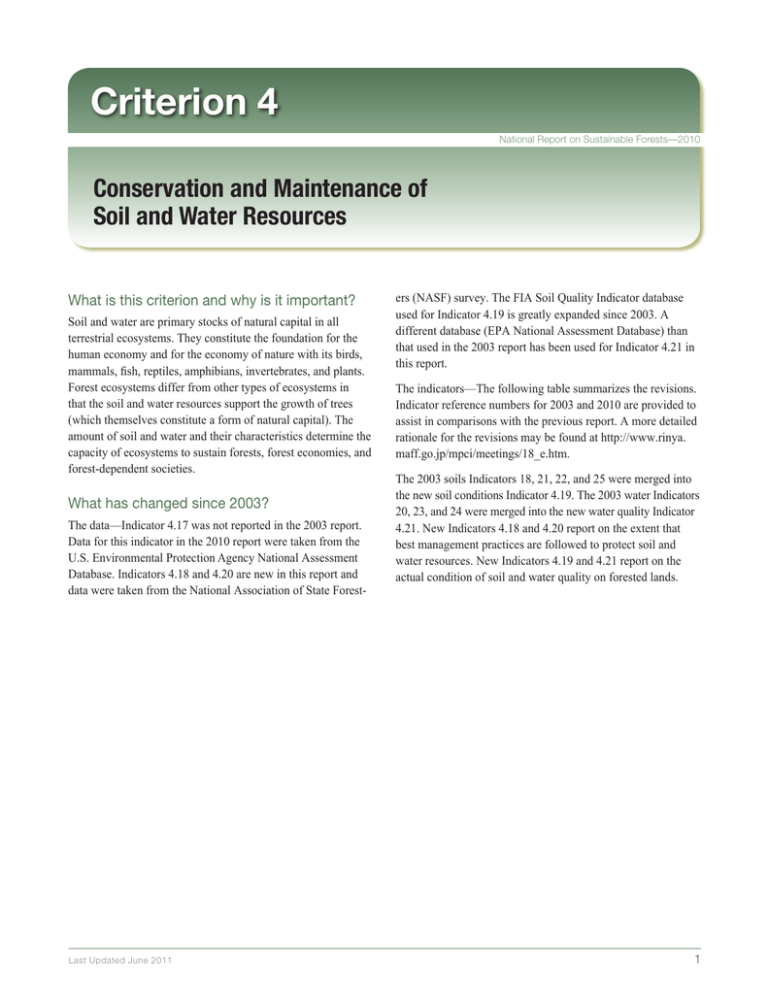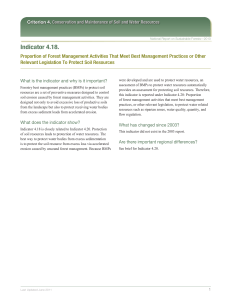Criterion 4 Conservation and Maintenance of Soil and Water Resources
advertisement

Criterion 4 National Report on Sustainable Forests—2010 Conservation and Maintenance of Soil and Water Resources What is this criterion and why is it important? Soil and water are primary stocks of natural capital in all terrestrial ecosystems. They constitute the foundation for the human economy and for the economy of nature with its birds, mammals, fish, reptiles, amphibians, invertebrates, and plants. Forest ecosystems differ from other types of ecosystems in that the soil and water resources support the growth of trees (which themselves constitute a form of natural capital). The amount of soil and water and their characteristics determine the capacity of ecosystems to sustain forests, forest economies, and forest-dependent societies. What has changed since 2003? The data––Indicator 4.17 was not reported in the 2003 report. Data for this indicator in the 2010 report were taken from the U.S. Environmental Protection Agency National Assessment Database. Indicators 4.18 and 4.20 are new in this report and data were taken from the National Association of State Forest- Last Updated June 2011 ers (NASF) survey. The FIA Soil Quality Indicator database used for Indicator 4.19 is greatly expanded since 2003. A different database (EPA National Assessment Database) than that used in the 2003 report has been used for Indicator 4.21 in this report. The indicators––The following table summarizes the revisions. Indicator reference numbers for 2003 and 2010 are provided to assist in comparisons with the previous report. A more detailed rationale for the revisions may be found at http://www.rinya. maff.go.jp/mpci/meetings/18_e.htm. The 2003 soils Indicators 18, 21, 22, and 25 were merged into the new soil conditions Indicator 4.19. The 2003 water Indicators 20, 23, and 24 were merged into the new water quality Indicator 4.21. New Indicators 4.18 and 4.20 report on the extent that best management practices are followed to protect soil and water resources. New Indicators 4.19 and 4.21 report on the actual condition of soil and water quality on forested lands. 1 National Report on Sustainable Forests—2010 Criterion 4. Conservation and Maintenance of Soil and Water Resources. 2003 Reference 2003 Indicator Revision Action 2010 Reference 2010 Indicator Protective Function 19 Area and percent of forest land managed primarily for protective functions (e.g., watersheds, flood protection, avalanche protection, and riparian zones) Wording change 18 Area and percent of forest land with significant soil erosion Merge to new Indicator 4.19 21 Area and percent of forest land with significantly diminished soil organic matter and changes in other soil chemical properties Merge to new Indicator 4.19 22 Area and percent of forest land with significant compaction or change in soil physical properties resulting from human activities Merge to new Indicator 4.19 25 Area and percent of forest land experiencing an accumulation of persistent toxic substances Merge to new Indicator 4.19 4.17 Area and percent of forest whose designation or land management focus is the protection of soil or water resources Soil NEW 4.18 Proportion of forest management activities that meet best management practices or other relevant legislation to protect soil resources NEW 4.19 Area and percent of forest land with significant soil degradation NEW 4.20 Proportion of forest management activities that meet best management practices, or other relevant legislation, to protect waterrelated resources NEW 4.21 Area and percent of water bodies, or stream length, in forest areas with significant change in physical, chemical, or biological properties from reference conditions Water 20 Percent of stream kilometers in forested catchments in which stream flow and timing have deviated significantly from the historic range of variation Merge concept to new Indicator 4.21 23 Percent of water bodies in forest areas (e.g., stream kilometers, lake hectares) with significant variance of biological diversity from the historic range of variability Merge concept to new Indicator 4.21 24 Percent of water bodies in forest areas (e.g., stream kilometers, lake hectares) with significant variation from the historic range of variability in pH, dissolved oxygen, levels of chemicals (electrical conductivity), sedimentation, or temperature change Merge concept to new Indicator 4.21 Last Updated June 2011 2



